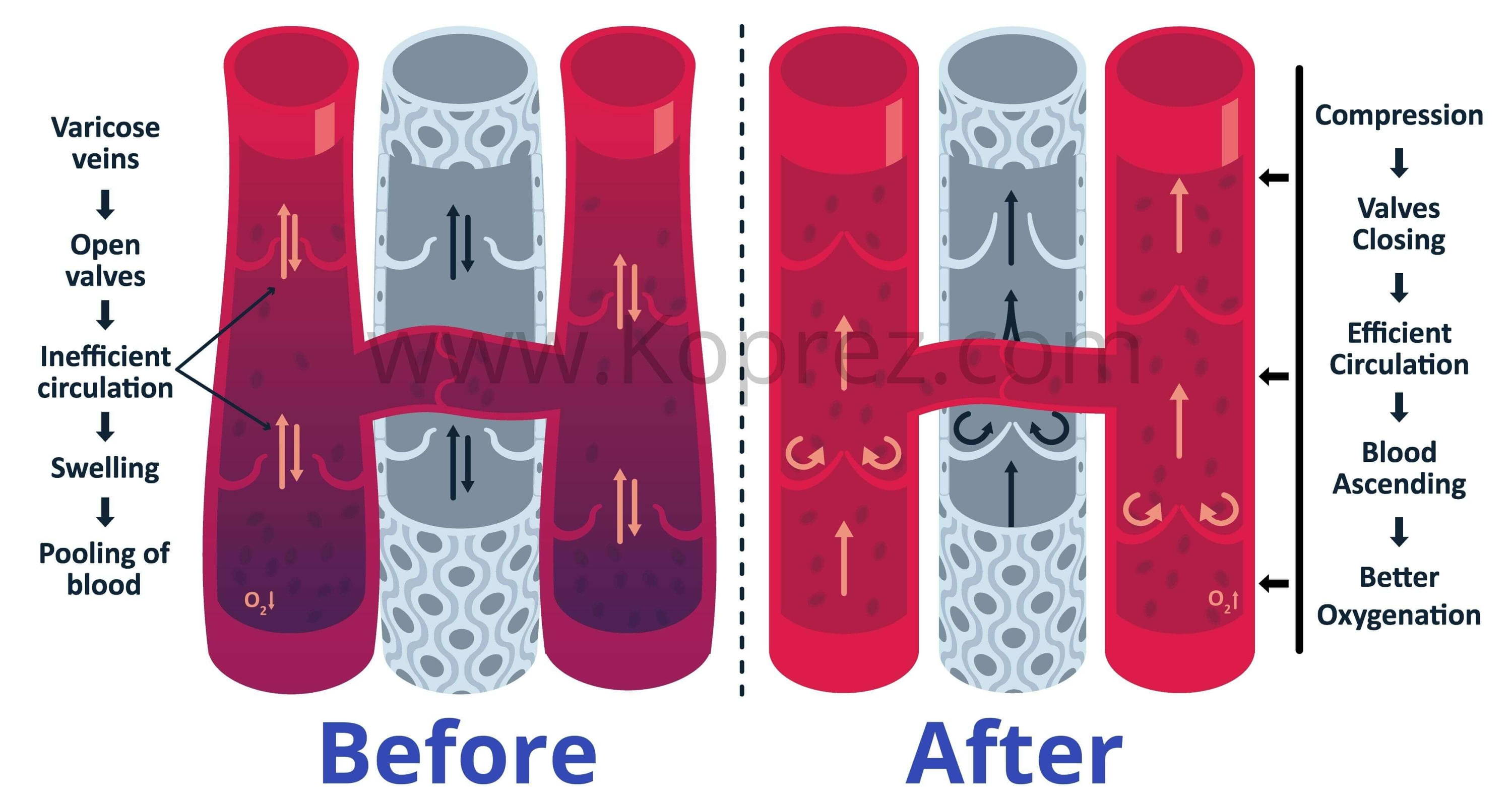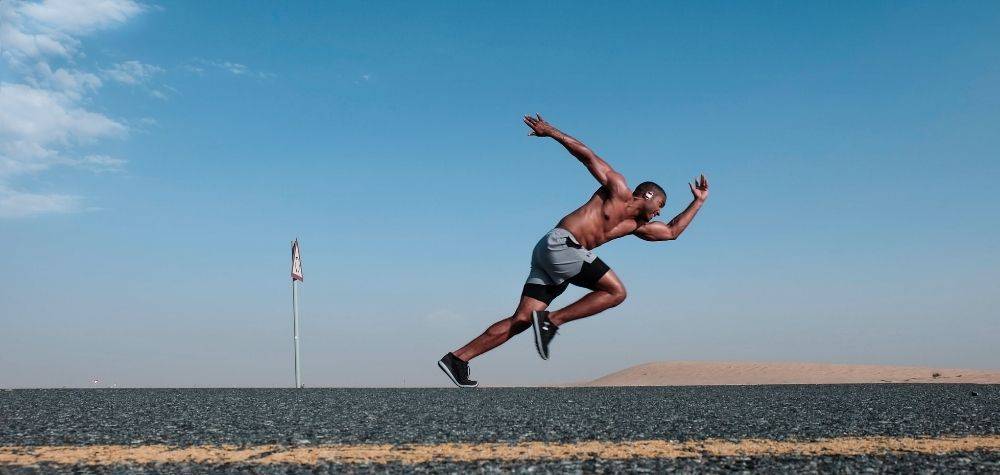Compression products are beneficial to more people than just athletes. While it could be crucial during recovery for an athlete, compression helps relieve pain that is commonly suffered. For example, look at what arthritis does to millions of people. It causes the joints to ache and jolts of pain stop people from working out.
With compression technology, provided support on the joints helps people combat pain during a workout or even during everyday life. But what is it that makes compression so effective for many? What are the actual benefits of compression therapy?
Today, we’ll be looking at the science behind compression and what it says about the benefits.
Simply put, compression therapy is a form of non-invasive and conservative treatment that aims to reduce pain and swelling around certain parts of the body. It works by applying a steady pressure over an area of skin or tissue using either static (elastic bandages) or dynamic (compression socks, compression tights or sleeves) compression. At its core, compression aims to increase blood pressure in the region and drain lymphatic fluid.
Wondering if compression is right for you? Let’s take a look at the conditions and symptoms that are most helped by compression, and how it helps:
There are compression garments that target various body parts. If you’ve ever felt long-term nagging effects from an injury or surgery, you can probably find a compression brace that suits you.
Here’s a list of available compression garments for targeted body parts:
● Gloves
Each compression garment has loads of benefits that boosts your body's performance during active exercise. Compression gloves for example, prevent finger, hand, and wrist pain almost instantly. How does compression do this? It increases blood flow in the targeted area by up to 40%. Extra blood flow means that you’ll have reduced stiffness and inflammation.
%20(1)%20(1).jpg)
The dynamic compression works by closing valves while the garment is on. Efficient circulation then begins which helps blood ascend rather than swell. Lastly, your body receives better oxygenation instead of your blood pooling up from swelling.
The benefits of compression therapy include the following:
As you wear compression garments, it applies controlled pressure to certain parts of your body. Compression therapy gently squeezes the blood vessels, helping blood move around more easily. The result? More oxygen and nutrients are delivered to the tissue and muscles, allowing them to heal faster.
Think about when you sprain an ankle and it swells up. Compression therapy is like a super helpful friend who gently pushes down the swelling. It does this by helping extra fluid that causes the swelling to move back into the bloodstream.
After a good workout, muscles can be sore and tired. Compression gear acts like a comforting hug for your muscles. It helps reduce the little tears that happen during workouts, which can lead to less soreness.
Sometimes, parts of the body hurt because blood isn't flowing well. Compression therapy is like a guide, leading the blood through the pathways in your body, which can help ease some types of pain.
Deep vein thrombosis is a condition where blood clots form in deep veins, usually in the legs. Compression therapy works by preventing blood clots and increasing the efficiency of the lymphatic and venous systems.
When you have a wound or an injury, your body needs all the nutrients it can get for healing. Compression therapy helps by speeding up the delivery service of blood to these areas, bringing along with it these healing nutrients.
Just like how a splint supports a broken bone, compression sleeve holds your muscles and joints in place. Compressing the muscles helps blood flow
Athletes love compression gear because it's like having a personal trainer for their muscles. It helps them move better, recover faster, and perform at their best.
People with lymphedema have extra fluid build-up that causes swelling. Compression garments are like super-absorbent sponges, helping to squeeze out this extra fluid, reducing the swelling.
Orthostatic hypotension means getting dizzy when you stand up. This happens because blood isn't returning to the heart fast enough. But with compression therapy, it's like adding an extra lane on a highway, helping blood get back to the heart more quickly, reducing dizziness.
Oxygen also has the amazing capacity to help heal injuries. When your blood circulation is improved due to compression, the influx of oxygen in the affected area works on your muscle tissues and promotes your body’s natural healing process.
Compression garments also keep your muscles and limbs stable, preventing them from moving, twisting, tearing, and otherwise causing further damage. This allows the injury to heal quickly and efficiently instead of turning into a persistent problem.
What if you’re not injured? Can a compression garment still benefit you? The answer is yes!
Compression works for all sorts of maladies, not just muscle injuries. If you have arthritis, tendinitis, carpal tunnel, or any kind of pain in your limbs and bones, a compression garment will reduce your discomfort by keeping the affected area stable.
A compression sock or sleeve is extremely useful for people who exercise or perform intense physical activities, like sports or lifting weights. Compression keeps your muscle fibers from vibrating, which prevents the secretion of lactic acid throughout that part of your body. Lactic acid makes you feel weak and fatigued - not ideal side effects for people who want to improve their strength and endurance.
Compression also keeps your muscles stable and warm so that you are less likely to become injured by twisting, tearing, or straining them.
A study that focused on rugby players wearing compression garments showed that wearing one during recovery is worthwhile. Wearing compression garments during a sprint test resulted in better sprint times, diminished fatigue, and delayed muscle soreness.
Compression socks vary in style such as knee-high versions that relieve and prevent leg pain during activity. Similar to the gloves, compression socks boost your blood flow and increase oxygen for full potential. Runners of all levels try compression socks in order to perform better and speed up recovery.
.jpg)
One study showed that runners wearing compression garments likely performed better during a run and recovery was boosted. Time to exhaustion, clearance of blood lactate, exertion, and peak muscle power saw at least a small positive effect. The body core temperature had a moderate effect due to compression, while leg soreness (afterwards) and muscle fatigue had large positive effects.
While the term "release toxins" is often used in health and wellness circles, it's a bit misleading. Our bodies have complex systems (like the liver and kidneys) that are designed to process and remove toxins. What compression therapy can do is improve circulation, which aids these systems to function more efficiently. So indirectly, yes, better circulation can help your body get rid of waste products more effectively.
The duration of compression therapy depends on the reason you're using it. For instance, if you're an athlete using it for recovery after a workout, you might wear compression garments for a few hours afterwards. For chronic conditions like lymphedema or deep vein thrombosis, you may need to wear compression garments most of the day, or as advised by your healthcare provider. As always, you should follow your healthcare provider's recommendations.
Compression garments don't directly burn fat. However, they can improve athletic performance and comfort during workouts, allowing you to exercise longer or more intensely, which can in turn contribute to weight loss and fat burn when combined with a healthy diet.
Yes, one of the benefits of compression therapy is reducing inflammation. It does this by improving blood flow which helps to decrease swelling and inflammation, particularly in the limbs.
While compression therapy is generally safe, some people may experience side effects. These can include skin irritation, discomfort or a tingling sensation, and in rare cases, it can cause circulation problems if the garment is too tight or worn improperly. It's important to get the right fit and follow guidelines on how long to wear your compression garment, and consult with a healthcare provider if you experience any issues.
Compression garments could be worn anywhere besides physical activity. It’s a great method for fast results and that reduces the pain on your joints. You could carry on with your daily life with additional support, and pain-free. Enjoy the benefits of increased blood blow, oxygen, and reduced swelling on your joints.
Remember to find a compression garment that fits you properly so you don’t have any restrictions. Our mission at Koprez is to work extra hard designing your products because your health is the most important thing in the world. Everybody deserves a happy life. We hope nagging joint pain doesn’t stop you from living the life you want to live.